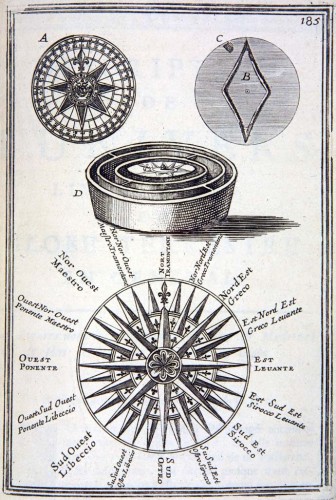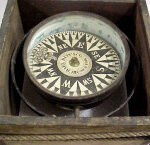Compass
Tool
Medieval
Quick Facts:
The first practical compass seems to have been made in Venice in 1274. It was a device supporting a magnetized needle over a card showing four or eight points of direction.
Introduction
A compass is a navigational tool with a magnetic needle that points towards the magnetic north pole. People have used this device for hundreds of years. Explorers in the past were able to sail and navigate around the globe because of this small, but handy tool.
History
A compass is useful navigational tool that relies on magnetism to work. While there are different types of compasses, early explorer’s relied on magnetic compasses in navigation. The earth’s surface is covered by an invisible magnetic field. The north and south poles are aligned with the earth’s axis. Therefore, magnetic objects, like the needle of a compass, will align itself along the north-south axis.1 Magnetic compasses evolved from using lodestones. Lodestone is a type of magnetic mineral called magnetite. At sea there were two ways of using a lodestone: The first was to hang it from a string, and allow it to turn and point north. The second was to float it on a piece of wood in a bowl of water, where it would drift towards the north. Using the bowl of water method was better for sailors, because holding a string steady on a moving ship could prove difficult at times. Many historians have traced these early compass-like devices to ancient China before 1040.2 As trade between Asia and Europe increased, European travelers most likely brought back using this concept back with them.3
Around the late 1200s to early 1300s, sailors started using a dry compass. This new advancement used a pivoting needle attached to a compass card in a wooden box. The direction points of the compass card looked like a rose. So navigators often refer to this type of compass as a “compass rose.”4 Over the next hundred years, navigators and sailors, such as Christopher Columbus, relied on the compass to help them sail to new parts of the globe.
How It Works
The compass rose would be placed inside of a box. On the compass rose would be the general direction markings – North, South, East, and West. However, more details rose patterns may include those directions, plus more specific directions – such as North-East or South-West. The name for this type of pattern is fleur de lis – French for “lily flower.” So how does it work?
The compass is a pretty simple device to use. Allow the magnetic needle to point North. Based on this knowledge, the navigator can then create his desired course.
Endnotes
- Don Geary, Using a Map and Compass (Pennsylvania: Stackpole Books, 1995), 5.
- Dana Meachen Rau, Become an Explorer: Make and Use a Compass (Chicago: Norwood House Press, 2011), 8.
- Rau, Become an Explorer, 8.
- Rau, Become an Explorer, 8 – 9.
Bibliography
Geary, Don. Using a Map and Compass. Pennsylvania: Stackpole Books, 1995.
Rau, Dana Meachen. Become an Explorer: Make and Use a Compass. Chicago: Norwood House Press, 2011.
Gallery
- Miniature Compass (courtesy The Mariners’ Museum collection – catalog# 1937.2489.000001)
- Liquid Compass (courtesy The Mariners’ Museum collection – catalog#1971.0146.000001A)
- Dry Compass ((courtesy The Mariners’ Museum collection – catalog#1964.0123.000001)
- Dry Compass (courtesy The Mariners’ Museum collection – catalog#1935.1053.000001)





